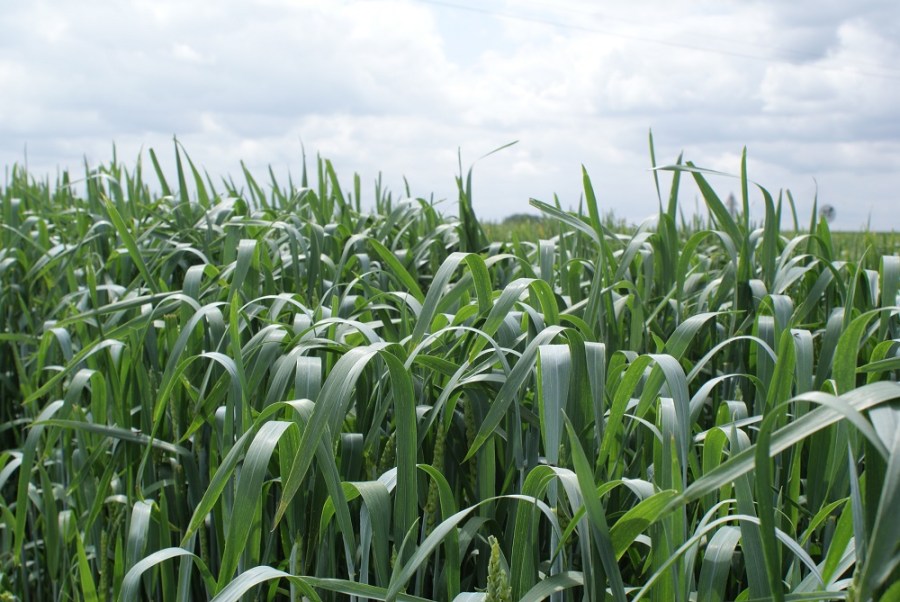Interest in biostimulants is increasing globally, but with limited knowledge about how they work, there’s still widespread scepticism about their efficacy. CPM unravels the mystery behind Interagro’s latest offering – Bridgeway.
Feeding a plant additional amino acid acts like a vitamin drink.
By Charlotte Cunningham
There’s no denying that crop protection is becoming an increasing concern for arable growers. From glyphosate to neonicotinoids many crucial controls have come up against scrutiny lately, leaving farmers in the dark about what may or may not be available in the years to come – on top of the increasing threat of chemical resistance.

Emma Ralph wanted to be sure Interagro had a product that provided valuable and measurable benefits to growers.
As a result, there’s been growing interest in alternative products like biostimulants which offer the potential to increase yields and boost crop health – reducing the reliance on chemistry that could indeed become limited in supply. However, with restricted knowledge about how they work, a lack of proven evidence and dubious suppliers, the efficacy of biostimulants has remained largely unproven.
As great believers in the benefits of biostimulants, Interagro has developed an amino acid-based biostimulant – Bridgeway – which has proven to boost yields and increase quality in a range of arable and horticultural crops. But what triggered the chain of events that led to the birth of this product?
“A study conducted by the Andersons Centre in 2015 reported that, while there was a growing interest in biostimulants, a number of factors were prohibiting producers from buying into them,” explains Emma Ralph, director at Interagro UK.
“These included limited independent evidence, little agronomist belief in the products, a questionable return on investment and not enough evidence that they support plant quality and limit stress. As a result of the findings, we identified a gap in the market, and knew we had to create something that addressed these issues and provided valuable and measurable benefits to growers.”
To tackle concerns over the improvements in plant quality, Interagro opted for an amino acid-based product, as amino acids are known to support abiotic and biotic stress tolerance to factors like drought and cold, and increase nutrient uptake, explains Emma.
“Amino acids are the building blocks of every living cell. In good conditions, plants can usually produce all 20 amino acids they require, but in conditions such as poor light or drought, photosynthesis is inhibited, and amino acid production is reduced at a crucial stage of crop development. Bridgeway provides all 20 amino acids required by the crop for optimum protein formation.
“Feeding a plant additional amino acid acts like a vitamin drink – it boosts the plant, helping it to overcome stress and kick start photosynthesis,” she adds. “They’re a safe and smart way to boost the efficiency of a crop’s metabolism and increase crop quality and yield, which may otherwise have been compromised. Crops also benefit from an extra energy boost as Bridgeway contains 5% nitrogen and 17.5% biological organic carbon.”
Another factor that weighed heavily on the design of Bridgeway was its product origin. Most amino acid products are of animal origin – using hide, blood and bone – and produced using chemical hydrolysis, which involves heating these components to high temperatures in hydrochloric acid, explains Emma.
“Amino acids produced through this process can’t be fully utilised by the crop. There are also growing food safety concerns about their use on the edible part of the crop – leading to them being banned for use on milling wheat in 2017 by the millers association nabim.”
However, unlike around 95% of amino-acid biostimulants, Bridgeway is a plant-based product – giving it a unique edge in a competitive market, she says. “Only amino acids of plant origin can be fully assimilated by the crop.”
It’s a key consideration, adds Emma, especially in the light of growing concerns over food fraud and an increase in veganism. “We need to be more aware of the way in which our food is produced. With increasing focus on the food chain and traceability, we set out to produce something that was not only better for plants and markets but also more acceptable for end users.”
As it’s based solely on plant-derived vegetable amino acids and peptides, Bridgeway has non-restricted approval by both the Soil Association and Organic Farmers and Growers for use on organic crops, making it suitable for a multitude of end users.
No project comes without its challenges, however, and for Interago, the production process appeared to be the most difficult, notes Emma. “It’s a very strict and controlled process to meet the stringent requirements that enabled us to have unrestricted approval for use in organic crops. The same complexities don’t exist in the production of animal-based biostimulants – so this was something we had to work meticulously to overcome.”

Fast forward three years and after two years of replicated trials and a year of on-farm testing on a variety of crops, Bridgeway will be launched to the market this spring. The flexibility of the product means growers of all crops can benefit, with Bridgeway proven to increase yields and quality in crops such as strawberries, pears, spring barley, winter wheat and sugar beet, she adds.
The product can be applied as a foliar spray on all agricultural and horticultural crops (organic or conventional), with a recommended rate of 1-3 l/ha at each application and a water volume of over 100 l/ha, depending on the crop, says Emma. “Traditionally, plants absorb nutrients through their roots, but foliar application is like a blood transfusion – it’s the fastest method to correct a deficiency, delivering what the crop needs, when it needs it the most.”
A neat feature is that, unlike many other products, Bridgeway can be used throughout the whole growing phase, and is recommended for use at the key phases of crop establishment – vegetative growth, flowering and fruiting – or prior to and following a stress condition, adds Emma.
The big question to combat the scepticism in the market is ‘does it work’? “The feedback from growers so far has been really positive, and many have been impressed with the difference adding Bridgeway into the programme can make,” she explains. “Especially with sugar beet, growers have reported noticeable visual differences in the health and appearance of the crop.”
And it’s not just producers that are seeing the benefits – agronomists are impressed, too. Bridgeway was put to the test on sugar beet by Frontier Agriculture, with a split field demonstration carried out in spring 2017.
The demo saw the 12ha plot of KWS Darnella split into two, with one side receiving two applications of the product while the other had just a basic fungicide programme applied. “We applied 3 l/ha of Bridgeway at two true leaves on 17 May 2017 and a further 3 l/ha at six true leaves on 31 May 2017,” explains Frontier agronomist Ryan Baker. “By the end of June, we were starting to see a noticeably greener canopy. At harvest, we noted positive trends in yield and sugars.”
With the future of many crop protection products uncertain, there’s clearly a gap in the market for biostimulants, says Ryan. “Some people are yet to consider the potential benefits of these type of products, but with restrictions on products increasing, it’s definitely something I recommend looking into.”
So, what’s next for the firm that brands itself as the adjuvant expert? “Over the next year we’ll be trialling sister products stemmed from Bridgeway’s design,” explains Emma. “Technology is evolving and so is the increased need for traceability of products used in food production, so naturally our chemistry has to reflect that.
“Biostimulants provide peace of mind, for both organic and conventional growers – that there’s a way to minimise the threats to yield by making their crops fitter and healthier, with the added potential to build yield for longer.”
What are biostimulants?
Agricultural biostimulants are substances that have the capacity to modify physiological processes of plants which, when applied to crops, provide potential benefits to growth, development, stress relief and subsequently yield, explains Emma. “Many biostimulants have a direct effect on the health of a plant by boosting the efficiency of plant nutrients – by improving uptake or reducing leaching – and some improve a plant’s ability to resist disease.”
Biostimulants come in a number of forms which can be classified into two different groups: Non-microbial and microbial. “Microbial options include plant growth promoting bacteria and rhizobacteria while non-microbials include seaweed extracts and amino acids,” she adds.
Success with cereals
As the use of biostimulants becomes increasingly popular, so does their availability, making navigation through the realms of products on offer a challenging process. However, Bridgeway really stood out to Dick Neale, technical manager at Hutchinsons.
“With these types of products, we test them out in the field first to see if there’s any intrinsic activity from them before moving onto a more complex trials package – the majority of products don’t go past field level.”
However, Bridgeway was different. “There were clear physical changes to the crop,” he says.
Hutchinsons carried out tramline trials on RGT Planet spring barley and KWS Siskin winter wheat and produced some pretty impressive results. “Bridgeway was introduced into the fungicide programme as an additive and we did three applications of 2 l/ha at growth stage 31, 39 and 65,” notes Dick. “As well as this, a base application of phosphite was applied at GS30.”
In the spring barley trials, a significant reduction in brackling was noted, resulting in a 1t/ha yield increase. “The architecture of the spring barley definitely improved. And in the winter wheat there was a difference in stubble colour; it was much more golden due to the overall improvement to crop health. As well as this, it achieved a 3t/ha yield response.”
So why does it work? “The chemistry provides protein building blocks for the crops,” explains Dick. “What’s also interesting is that after the winter wheat was harvested, we carried out an oilseed rape trial using 9m strips. What we could see in the Bridgway strip was a noticeable improvement in the OSR, likely due to the recycling of nutrients from the wheat crop, enhancing the OSR.”
After being thoroughly impressed with its first experience with Bridgeway, Hutchinsons is now continuing to experiment with the product, testing application rates and timings. “We’ve just received data from a replicated trial on sugar beet where a 10% increase in leaf biomass has been recorded from 2l/ha of Bridgeway. We’re awaiting yield and sugar data, but this is a very significant result.”
Innovation Insight
CPM would like to thank Interagro for kindly sponsoring this article, and for providing privileged access to staff and material used to help put the article together.





